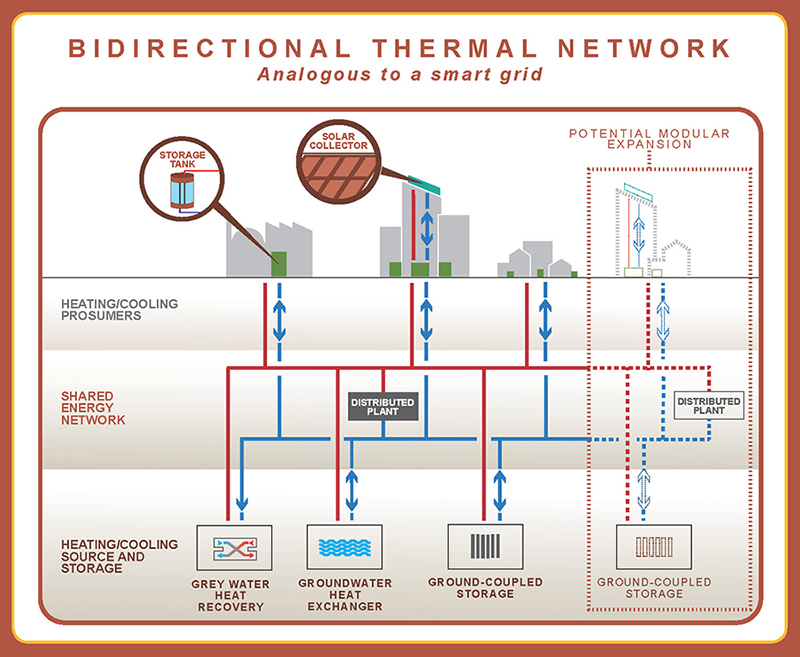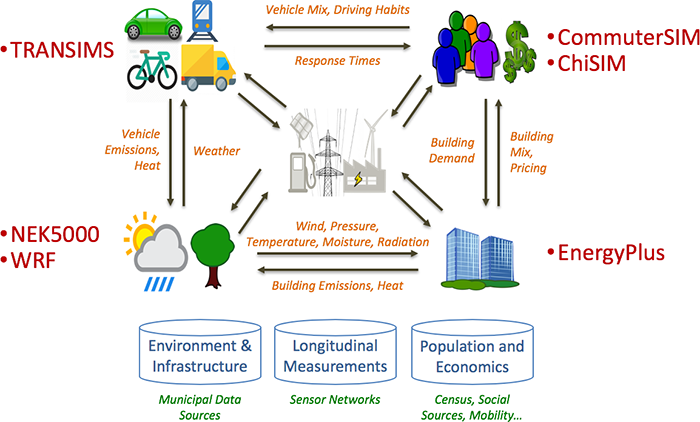Research Areas
Research Areas
We are conducting a diverse and synergistic array of research on urban science.
Urban Building Energy Modeling (UBEM)
UBEM refers to the computational modeling and simulation of the performance of a group of buildings (from a city block to a district and to an entire city) in an urban context, to account for not only the dynamics of individual buildings but, more importantly, the inter-building effects (e.g., shading and radiant heat exchange) and the mutual influences between buildings and the urban microclimate, providing quantitative insights to inform urban buildings and energy policymaking. Considering urban buildings as part of the urban system (a system of systems) will enable a group of buildings to achieve greater performance than the simple sum of individual buildings.
District Energy Systems
A bidirectional thermal network for district heating and cooling is analogous to a smart grid in that the direction of the water flow reverses depending on the heating or cooling needs of its consumers. Buildings can feed waste heat and excess renewable energy into the grid, and offer storage capabilities as well. Such networks exhibit very high efficiency if used with heat pumps, and can play a key role in increasing resilience.

As these systems can be built out modularly, they can gradually be expanded by adding new buildings and new generation and storage, allowing for incremental investments.
They have been shown to be cost competitive with conventional heating systems in Switzerland, where they are a key part of the strategy to reduce building and energy demand by a factor of five. We will leverage our international partnerships built through our leadership within International Energy Agency activities and the International Building Performance Simulation Association, plus our collaboration with the Swiss Competence Center for Energy Research "Future Energy Efficient Buildings and Districts."(http://www.sccer-feebd.ch/)
We are developing tools and conducting technology demonstrations to enable design and operation of such systems, and research how to adapt them to different geographic circumstances. The anticipated outcome is a five-fold reduction in energy demand of buildings, and a transformation of building heating and cooling systems to bidirectional systems that can transact thermal energy in a dynamic market.
Urban Heat Island
The Heat Island Group at Berkeley Lab works to cool buildings, cities, and the planet by making roofs, pavements, and cars cooler in the sun. Details at heatisland.lbl.gov.
Resilience
With increasing frequency and severity of extreme weather events (e.g., heat waves), it is critical to ensure urban infrastructure and systems are resilient to provide critical services to preserve human life and properties during natural disasters. We are conducting applied research on methods and metrics to represent and quantify resilience of urban systems, as well as technologies and strategies to improve resilience of urban infrastructure.
Big Data and Machine Learning
Characterizing urban infrastructure to enable quantitative modeling and simulation needs lots of data. Although more and more cities provide public datasets at their open data portals, it is still a challenge to synthesize and utilize the data due to limited coverage and lack of common semantics. We use machine learning (deep reinforcement learning, clustering, Generative Adversarial Networks) techniques to extract useful information from diverse sources of city data including images, maps, social media, permits, and sensor data from monitoring systems such as the Array of Things.
High Performance Computing
To support the energy and environmental goals of cities as well as new development and redevelopment, interdependencies between sectors (e.g., buildings, urban climate, transportation, and socio-economic) need to be quantified and understood in order to achieve optimal design and policy. The Multiscale Coupled Urban Systems project, as part of the U.S. Department of Energy (DOE) Exascale Computing Project, aims to develop a computational framework to enable related urban models to run as an ensemble of coupled models facilitated by a data hub. This project is a joint effort between ANL (Charlie Catlett, PI), LBNL (Tianzhen Hong, Co-PI), and ORNL (Jibonananda Sanyal, Co-PI).
Coordinating multiple models in ensembles for the purpose of understanding a specific system involves a number of hurdles. First, the models may be from different scientific domains and may implement different modeling paradigms that need to be harmonized. For example, one model may be a time-stepped, deterministic simulation of a physical process, while another might be a stochastic microsimulation model, requiring many stochastic variations to be run in order to generate interpretable distributions of outputs. Therefore, simple time-stepped co-simulation is not sufficient.
Additionally, models can be implemented in a variety of programming languages and to require them to be ported to a common language just so they can be used in concert is often too high a hurdle for practitioners. Adding to these issues the requirement that these ensembles of models should be run on large-scale systems introduces the unique idiosyncrasies associated with those systems. We implement a hub that can lower these model coordination hurdles, and coordinate urban microclimate data generated using Weather Research and Forecasting Model (WRF) with DOE's flagship building energy simulation program EnergyPlus.

We also ran large scale (tens of millions) EnergyPlus simulations using the National Energy Research Scientific Computing Center facility to evaluate cost-effective energy efficiency measures of commercial buildings. This is a feature of the Commercial Building Energy Saver toolkit, more information is available at cbes.lbl.gov.
